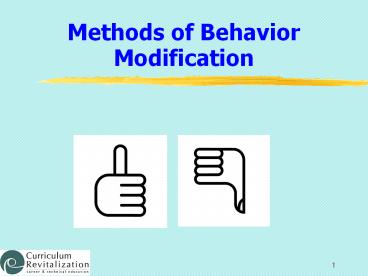Methods of Behavior Modification - PowerPoint PPT Presentation
Title:
Methods of Behavior Modification
Description:
Methods of Behavior Modification * * Student Learning Objectives 1. Compare and contrast positive and negative reinforcement. 2. Evaluate the effects of punishment. – PowerPoint PPT presentation
Number of Views:302
Avg rating:3.0/5.0
Title: Methods of Behavior Modification
1
Methods of Behavior Modification
2
Student Learning Objectives
- 1. Compare and contrast positive and negative
reinforcement. - 2. Evaluate the effects of punishment.
- 3. Describe effective behavior modification.
3
Terms The following terms are presented in this
lesson (shown in bold italics)
- behavior modification
- corporal punishment
- external rewards
- internal rewards
- negative reinforcement
- positive reinforcement
- punishment
- self-efficacy
4
Objective 1
- Compare and contrast positive and
negative reinforcement. - Anticipated Problem
- What is the difference between positive and
negative reinforcement?
5
Objective 1 (contd)
- I. Positive and negative reinforcement
- A. Positive reinforcement is the giving or
granting of a reward based on a behavior. - 1. External rewards are tangible items (money,
trophies, toys, stickers, etc.) and also
intangible items (handshake, smile, words of
encouragement or praise, applause, etc.) used
to positively reinforce a behavior.
6
Objective 1 (contd)
- A. Positive reinforcement (contd)
- 2. Internal rewards are inner rewards that
encourage a person to repeat a behavior
(pride, sense of completion, personal
accomplishment, self-confidence.
7
Objective 1 (contd)
- B. Negative reinforcement is the removal of
something or the changing of a condition that
a person does not desire. By removing the
unwanted, it will allow a person to recognize
how his or her actions created an undesirable
circumstance. - Negative reinforcement is not the same as
punishment.
8
Objective 1 (contd)
- B. Negative reinforcement examples
- 1. Negative reinforcement may consist of
removing a childs toy airplane from a house
roof. The child wishes to play with the
airplane, but will learn through negative
reinforcement that if he throws it on the
roof, he can no longer play with it. - 2. It may also mean that a boss does not praise
an employee for a report that is
unsatisfactory. The employee will then work to
provide a satisfactory report to retrieve
praise from the boss.
9
Objective 2
- Evaluate the effects of punishment.
- Anticipated Problem
- How does punishment affect an individual?
10
Objective 2 (contd)
- II. Avoiding punishment
- A. Punishment consists of words or actions that
are unwanted by a person.
(examples a video game taken from a
child, speeding ticket given for driving too
fast,) - Punishment can be an effective way to
modify a persons behavior, however, it
does so in a negative way and should
be avoided.
11
Objective 2 (contd)
- II. Avoiding punishment (contd)
- B. Corporal punishment is the use of physical
force to inflict discomfort in order to change
behavior in a person. - (ex spanking, paddling a child - illegal in
public schools and childcare centers in
Illinois) - Corporal punishment can produce negative side
effects for the development of children and
should be avoided.
12
Objective 2 (contd)
- To read more about corporal punishment laws in
IL, visit - www.illinoislegalaid.org/index.cfm?fuseactionhome
.dsp_contentcontent ID2596 - To read more about IL Eldercare Law and resources
visit - www.illinoislegalaid.org/index.cfm?fuseactionhome
.dsp_Contentcontent ID4238
13
Objective 3
- Describe effective behavior modification.
- Anticipated Problem
- How is an individuals behavior
effectively modified?
14
Objective 3 (contd)
- III. Behavior modification
- A. Behavior modification is the practice of
changing unacceptable behavior through the
rewarding of acceptable behavior. It is the
most effective way to work with all ages and
development levels of people. It values all
people.
15
Objective 3 (contd)
- III. Behavior modification (contd)
- B. Behavior modification creates self-efficacy,
the ability of a person to build
self-confidence. - C. Behavior modification could be used as an
alternative to punishment in many ways.
16
Objective 3 (contd)
- C. Behavior modification examples
- 1. Provide a space where individuals can calm
themselves if needed. A quiet corner could
help a child or an adult calm down from a
stressful situation. - 2. Allow individuals to fix their own
undesirable behaviors. If a person spills a
liquid in the kitchen, permit them to clean
the mess, rather than punishing the behavior. - 3. Set clear expectations. Make sure that
people are aware of the rules that must be
followed.
17
Review
- List some examples of external rewards and
internal rewards. - What are the negative side effects of corporal
punishment? - Explain why behavior modification is the most
effective way to work with all ages to make a
change in unacceptable behavior.































